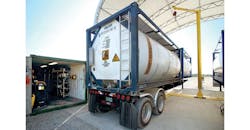Standardization would help in ISO tank maintenance and repair
WHY are ISO tank maintenance and repair so important? Because an accident by the vendor is a reflection on the company it serves, according to Curtis Williams, Honeywell’s global transportation and logistics lead for fluorine products.
In his presentation, “Standardization and ISO Tank M&R,” Williams said that a strict quality assurance process is needed. He discussed tank container maintenance and repair concerns during the Intermodal Bulk Liquid Symposium.
“Make sure that your safety standards are just as high as anybody else’s,” he said. “Those are what are important. The main reason for that is that not only does it give me operational efficiency, but I can allocate my resources better. If I have a release, nobody says, ‘Hey, what was the depot?’ They say, ‘Hey, there is a piece of equipment there. It’s got a load of product in it. It’s got a Honeywell logo on the side. It’s Honeywell.’
“Nobody in the news media, nobody at the incident site is ever going to go back and ask, ‘What depot did the work?’ It’s going to be me trying to explain this. So you are a reflection on the company you’re serving. There’s no excuse for not trying to do your best every day and not trying to make sure the processes and everything else are right.”
He suggested that a company should try to get as much operational efficiency as possible, whether it’s in the supply chain, logistics, tank container management, or what kind of software is being used. Once that is obtained, then the company can move on to allocating resources more appropriately and saving money, and that in turn gives the company agility.
He listed the logistics cost drivers in ISO tank container management:
• Time.
“For a large fleet, one week’s delay with one tank container out at one time can cost $250,000 in equipment cost over a cycle. Delayed bookings are costly. If that equipment is idle inside your facility, that’s costing you money. Delays in repair and testing … If I have to wait a week, again that’s a lot of money.”
• Regulatory compliance.
“Inability to import/export product heels is a significant concern. It’s a big cost driver for me. For example, if I have tank containers in Mexico with a certain product residue, I can’t bring them into the United States.”
• Chassis management.
“Poor chassis maintenance is an issue. One of things that we did was to have a maintenance manager for our container chassis. The chassis were all in poor condition. Anybody that had just looked at random chassis sees structural defects, poor welding. So what we’ve done is have a manual that says, ‘Here’s what it takes for our chassis to be operational. Inability to ground equipment is another factor that costs me money. With everything sitting on a chassis, it’s very expensive.”
• Utilization.
“We have a lot of issues that allow tank containers to sit around. That cuts our utilization rate on tanks containers.”
He said that he comes from the railroad industry, and when he got involved in ISO tanks, he was “dumbfounded” to see the lack of standardization.
“In the railroad industry, if anybody’s going to change a valve on my tank, I had a certain number of requisite forms that have to be submitted,” he said. “I can track and trace and make sure I’m not paying until I know the tank repairs have been done right. It’s not done that way in the ISO tank industry. There is a lack of standardization.”
The issues he has seen:
• Default rates at on-hire (lessor).
“Some have reached as high as 70%,” he said.
• Improper gaskets/torque procedures (manufacturing, depot).
“There’s a need for standard gaskets, lubrication, and torque process. Lack of standardization has led to releases, loss of product, and an inability to use leased equipment. One of the main reasons behind the 70% default rate was a lack of procedures.”
• Improper inspection of chassis/ISO tank (depot).
“I’ll see gaping holes on something that got an inspection a month ago. That tells me somebody didn’t do their job. That costs me money. I have to send it back to the depot and get it re-inspected and get it fixed. The whole time, my plant was on a strict loading schedule that I had to interrupt. That’s costing me hours and hours.”
• Improper cleaning (depot).
“It surprised me that I couldn’t really get a standardized definition from a proper procedural standpoint. Improper cleaning is dangerous and can result in a loss of product or an incident.”
His safety tips:
• “Some sort of standardization is needed. Vendors should handle chemicals and gases in the same manner as chemical plants.”
• “Use of proper PPE is a must. You have to know what’s in the tank.”
• “Do a Job Safety Analysis and figure out what you’re doing, what product you’re working with. Take time to figure out the hazards involved.”
• “I’ve been on audits where there are no intrinsically safe areas. People are walking around with cellphones and computers and plugging them into electrical outlets next to gas tanks. It’s only going to take one spark. That’s how you get more government regulations.”
He said that there needs to be firm adherence to an industry standard.
“I’d like to see more of this,” he said. “And do it without federal regulations. Like I said, it only takes one big accident and you’re going to have that.
“There should be industry-led repair certifications for personnel and shop. Is that guy actually trained in rebuilding my valve?
“There should be forms as a requirement of an industry standard for inspection and repair dealing with structural integrity, linings, component replacement or repair, maintenance, and cleaning.”
